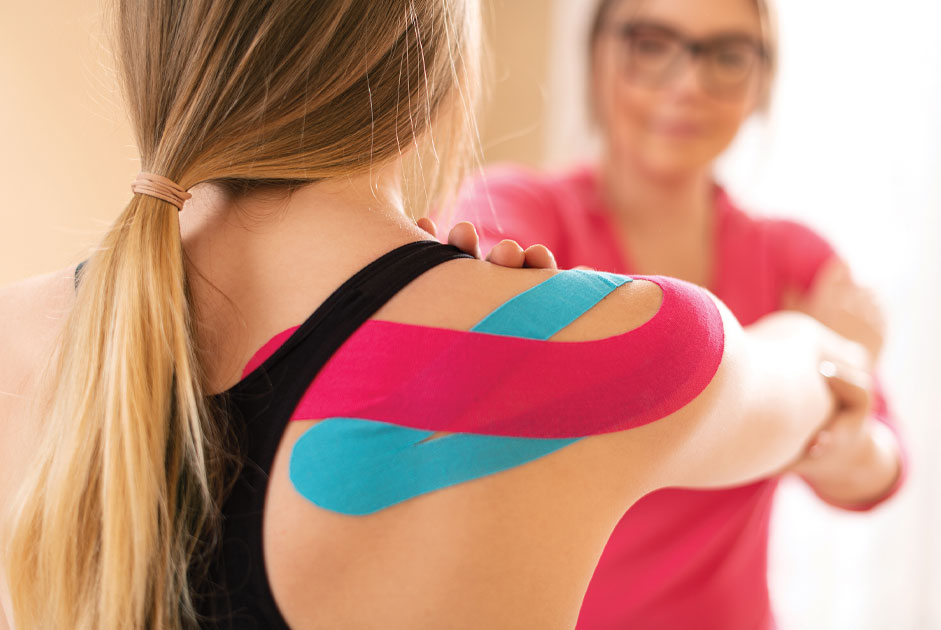You have probably seen KT Tape, a brand of kinesiology tape in your local pharmacy, or maybe you have seen it on numerous athletes on your television. It’s widely used in rehabilitation and physical therapy and is starting to be studied even more extensively than it has been in the past. It has even made its way into the animal therapy world since the benefits are just as grand for the four-legged creatures as it is for the two-legged!
Kinesiology, by definition, is the study of the body’s movement. Kinesiology tape was designed to move with the body, by providing a flexible tape with a good amount of stretch. This makes it quite different from sports tape that is very structured, without give, and likely used in cases when you do not want to allow movement of a joint.
Chiropractor Dr. Kenzo Kase developed kinesiology tape in 1973. Dr. Kase was treating arthritic patients and developed the tape so that the patients could extend the lasting benefits of better mobility and reduced pain after leaving his office for a session. He knew that the existing sport tapes wouldn’t be right for the job as they weren’t able to provide the mobility he knew was necessary for the patients to remain pain free.
Kinesiology tape was developed to mimic skin and works by application directly to the skin or fascia, which the body has designed with pain receptors. When the tape is applied it immediately works with the fascia to gently lift the layers. This creates a host of reactions in the body. When the fascia is lifted, your circulation immediately increases in the area the tape is applied and the surrounding areas. Blood flow increases due to the additional space. Experts say this single function of the tape can increase healing time as new, fresh blood and oxygen circulate to any area of damage or injury, and inflammation is reduced. The lifting effect of the skin allows any muscle constriction to find room to expand. Taping is a fantastic method for helping a sore, overused muscle heal and enables healthy muscles to perform even better, which is why many athletes may be sporting the tape without any injury at all. Apply the tape to any bruise and watch the skin where the tape is applied; the bruise under the tape will usually fade in that area faster than the surrounding areas.
Kinesiology tape can be applied in many different patterns and shapes depending on what area of the body you want to target and your overall goal. Due to the cotton blends and flexibility of the tape, you can cut and trim the tape without reducing its effectiveness. Some patterns of application can provide support to a joint or muscle, while other patterns are focused on reducing pain, or edema in specific areas. Kinesiology tape is beneficial when we need to tap in our lymphatic system. Breast cancer patients have been sent home with tape patterns to help reduce their lymphedemas. Estheticians are starting to use tape on the face to reduce wrinkles and fluid retention. For this application, a sensitive skin adhesive is best! Typically, the tape on the body is intended to stay for more than just overnight and the adhesives are strong enough to get wet in the shower and still last up to seven days.
Some brands have had more staying power than others. I have worn Sparthos brand tape, available on Amazon.com, for longer than a week and still find it sticky when removing it. The widely available KT Tape doesn’t last as long for me. Skin prep prior to application will help improve your wear time. Making sure skin is clean and dry without any oils or lotions applied is a must! Many brands offer different widths, from two to six inches, bulk rolls, pre-cut strips, extra sticky adhesive, sensitive skin adhesive, fun colors, and funky patterns. Whatever your preference, there’s a tape for you. Most tape brands will send a handy instruction page with suggested patterns for different areas of the body, but I find that searching what ails you on You Tube can be extremely helpful to determine where and how to apply tape to that area.
Adding kinesiology tape to your first aid kit is a great way to help decrease pain and increase your own body’s healing powers and maybe reduce the urge to reach for the ibuprofen!



















